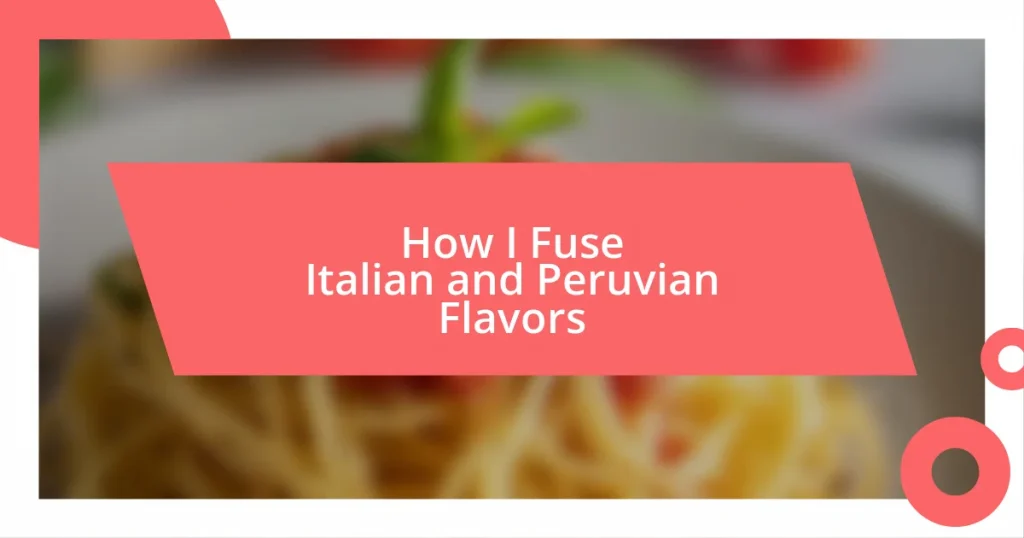Key takeaways:
- Italian cuisine emphasizes fresh, high-quality ingredients, fostering emotional connections through family meals.
- Peruvian dishes reflect a vibrant cultural history, using ingredients like ají amarillo and quinoa to celebrate diversity and flavor.
- Successful fusion cooking involves starting small with flavors, embracing improvisation, and considering guests’ preferences for a memorable dining experience.
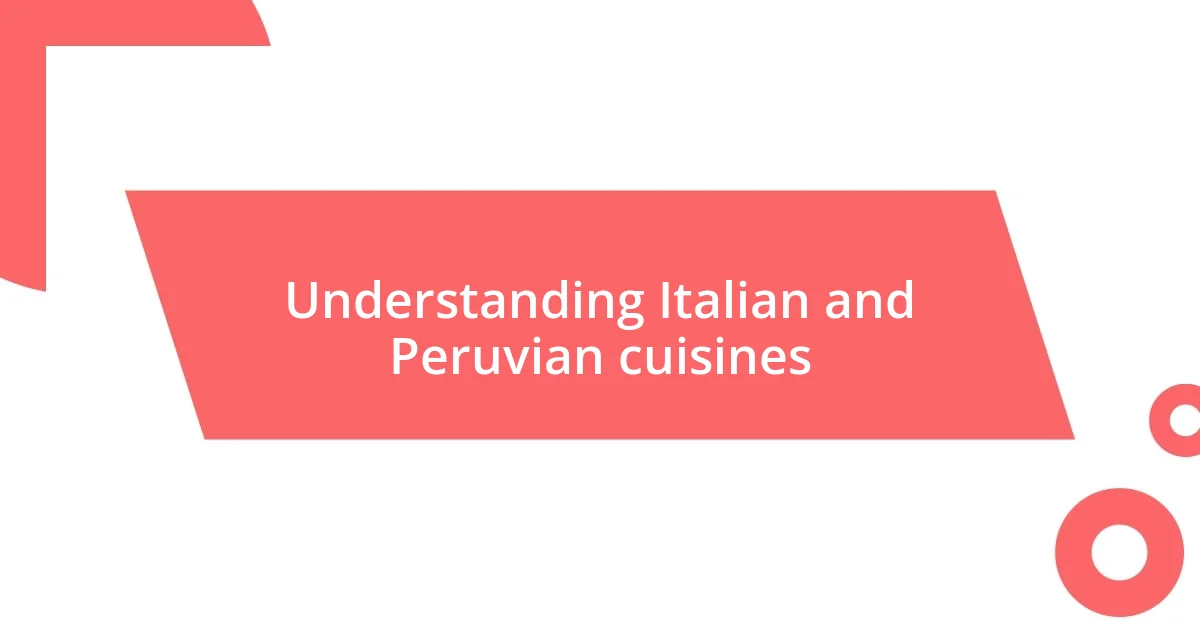
Understanding Italian and Peruvian cuisines
Italian cuisine is renowned for its rich, robust flavors and emphasis on fresh, high-quality ingredients. When I first tasted a homemade marinara sauce simmered with fresh basil, it felt like a warm hug, embodying the heart of family gatherings and shared meals. Isn’t it fascinating how dishes like risotto or pasta can evoke such deep emotional connections?
On the other hand, Peruvian cuisine bursts with color and diversity, showcasing a fusion of indigenous, Spanish, and Asian influences. I remember trying ceviche for the first time—the tangy citrus coupled with the freshness of the fish was a revelation. It’s a beautiful representation of Peru’s coastal bounty and vibrant culture. How incredible is it that a single dish can tell the story of a nation’s history?
Exploring both cuisines, I find that each has its own rhythm and pulse. Italian meals often bring a sense of tradition and family, while Peruvian dishes dance with the spirit of celebration and festival. Can you feel the difference? Such unique qualities invite endless possibilities for fusion, offering a canvas where cultures can blend harmoniously.
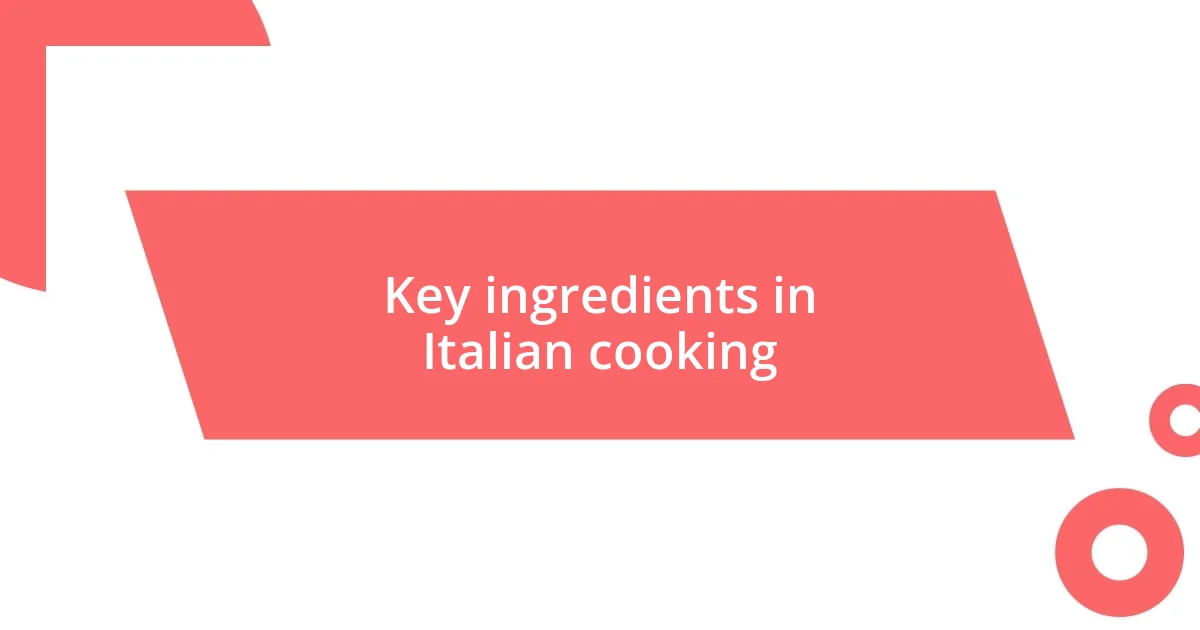
Key ingredients in Italian cooking
Italian cooking hinges on a few key ingredients that elevate dishes to culinary masterpieces. For me, the aroma of fresh garlic sizzling in olive oil instantly transports me back to my grandmother’s kitchen, where every meal was infused with love and tradition. The magic lies not just in the ingredients themselves, but in the stories they tell and the connections they forge during meals shared with family.
Key ingredients that define Italian cooking include:
- Olive Oil: A staple in Italian kitchens, used for everything from dressings to sautés.
- Garlic: Essential for flavoring sauces and enhancing the overall taste of dishes.
- Tomatoes: Fresh or canned, they’re the backbone of many Italian sauces, bringing acidity and sweetness.
- Fresh Herbs: Basil, oregano, and parsley add aromatic freshness that brightens up any dish.
- Cheese: From Parmigiano-Reggiano to mozzarella, cheese is crucial for texture and richness.
- Pasta: The foundation of countless Italian recipes, offering a hearty base for sauces.
Each ingredient not only holds significance but also resonates deeply within me. I remember a pasta dinner with friends, where the simplicity of the ingredients turned into a feast of flavors. That’s the beauty of Italian cooking; it’s about using quality ingredients to create something that feels like home, no matter where you are.

Key ingredients in Peruvian cooking
Key ingredients in Peruvian cooking are a vibrant testament to its diverse influences. One standout ingredient is aji amarillo, a bright yellow pepper that brings a mild heat and a sweet fruitiness to many dishes. I vividly remember the first time I tried aji amarillo sauce drizzled over grilled chicken—it was a game changer! The warmth of the pepper coupled with the smokiness from the grill made every bite a celebration of flavor.
Another cornerstone is quinua, or quinoa, which has been a staple in Peru for thousands of years. Its nutty taste and chewy texture can elevate any dish, whether it’s a salad or a side. I often find myself tossing quinoa salads with vibrant vegetables and fresh herbs, and it’s those colors on the plate that really get my appetite going. How rewarding it is to cook with ingredients that not only taste great but also carry such a rich cultural history!
Lastly, we cannot overlook potatoes, which Peru boasts over 3,000 varieties of! The way they can transform a dish astounds me. When I experimented with a creamy causa—a layered potato dish topped with avocado and tuna—I was struck by how simple ingredients could create something so comforting yet refined. These key ingredients are not just components; they are reflections of Peru’s essence, each carrying a story that adds depth to every meal.
| Ingredient | Description |
|---|---|
| Ají Amarillo | A bright yellow pepper that adds mild heat and sweetness, essential for many sauces. |
| Quinua (Quinoa) | A nutritious grain with a nutty flavor and chewy texture, often used in salads and sides. |
| Potatoes | With thousands of varieties, they are a staple in many Peruvian dishes, providing versatility and comfort. |

Techniques for blending flavors
When blending Italian and Peruvian flavors, one of my favorite techniques is to create fused sauces. Imagine a classic pesto infused with a touch of aji amarillo. The vibrant kick from the pepper plays beautifully with the aromatic basil and the nutty pine nuts, adding a new dimension to a traditional dish. I remember the first time I drizzled this sauce over a pasta dish; it felt like I was on a culinary adventure, combining the familiar with the unexpected.
Another approach I love is the art of layering flavors. Take a risotto as a base and incorporate Peruvian ingredients like quinoa and corn. The creamy texture of the risotto combined with the earthy crunch of quinoa creates a delightful contrast. One time, at a family gathering, I surprised everyone by serving this risotto. Each bite sparked curiosity and conversation, making the meal feel alive and interactive. Don’t you think food should be a conversation starter?
Lastly, I often experiment with marinades that utilize both cuisines. Mixing olive oil, lime juice, and garlic, I marinate chicken before grilling it, infusing the dish with Mediterranean warmth and a zesty Peruvian twist. I recall serving it alongside roasted potatoes and a tangy salsa verde, and the compliments kept rolling in. It struck me in that moment: blending flavors is not just about taste; it’s about creating connections and experiences. How does flavor fusion make you feel?
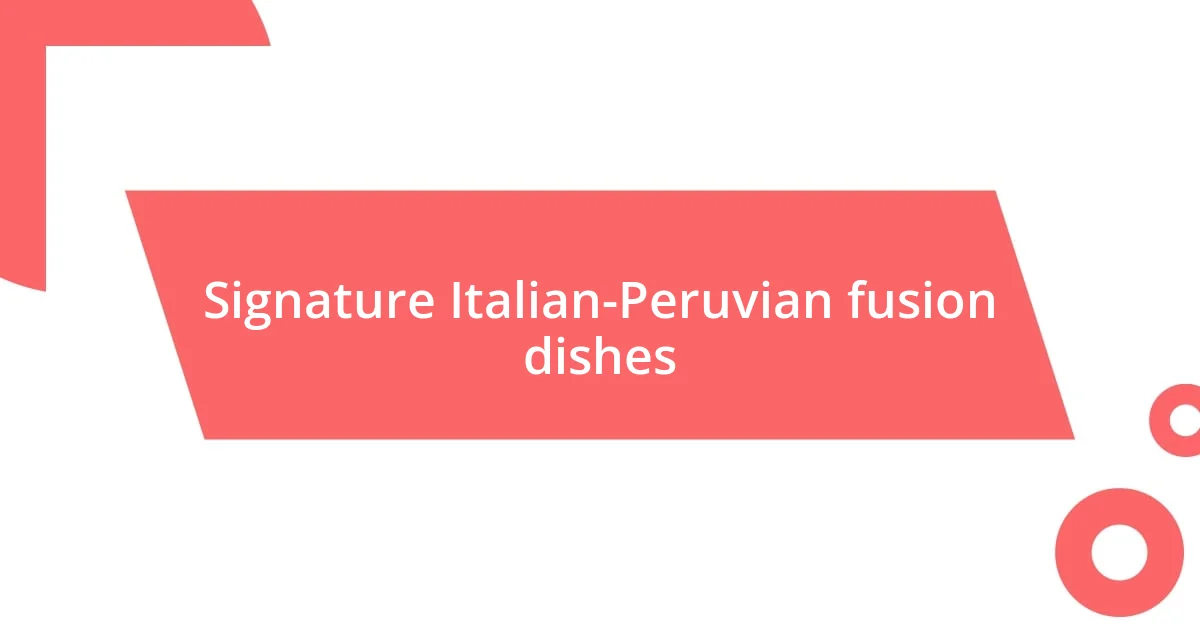
Signature Italian-Peruvian fusion dishes
One signature dish that brilliantly showcases the fusion of Italian and Peruvian flavors is Causa Relleno al Pesto. Imagine the classic Peruvian causa, made with creamy mashed potatoes, layered with a filling of fresh basil pesto, and perhaps some mozzarella and sun-dried tomatoes. The first time I plated this for friends, a wave of skepticism washed over them. But as they dove in, their surprised faces quickly turned into smiles of delight. It’s a delightful reminder that food can break boundaries and expectations.
Another standout is Fettuccine con Ají de Gallina, where the creamy Peruvian chicken sauce meets traditional Italian fettuccine. As I stirred the sauce on a cozy Sunday afternoon, the rich, nutty aroma enveloped my kitchen, evoking memories of family dinners. When I served this dish, it felt like a celebration, uniting my loved ones around the table. Ever had a moment where food instantly transported you back in time? This dish did that for me.
Lastly, I love crafting Chicha Morada Tiramisu. By infusing the classic Italian dessert with the sweet and tangy Peruvian purple corn drink, I create a quirky twist that surprises and delights. I once presented this at a dinner party, and watching my guests’ eyes widen in curiosity was a delightful thrill. Isn’t it fascinating how a simple dessert can spark conversations and connections? This fusion not only tantalizes the taste buds but also invites stories and joy to the table.

Tips for successful fusion cooking
When diving into fusion cooking, the key is to start small and let the flavors shine. I often find that just a pinch of an ingredient from one cuisine can elevate a dish without overwhelming it. I vividly remember the first time I added a hint of cumin to a classic Italian tomato sauce; the warmth it brought transformed the dish into something entirely new. How often do we underestimate the power of just a few carefully chosen spices?
Don’t shy away from improvisation! One of my favorite moments in the kitchen came when I ran out of traditional risotto rice and swapped it for arborio quinoa instead. The result was a creamy, unexpected twist that left my guests impressed and eager for the recipe. Embracing the unpredictability of fusion can lead to delightful surprises. Have you ever stumbled upon a culinary invention simply by experimenting?
Finally, always keep your audience in mind. When I host dinners, I make sure to consider my guests’ tastes and dietary preferences. I once catered a gathering featuring a light tiradito paired with a Caprese salad, and it was met with rave reviews. It’s important to engage your audience’s palate while also introducing them to new flavors. How do you tailor your dishes to appeal to those around your table?
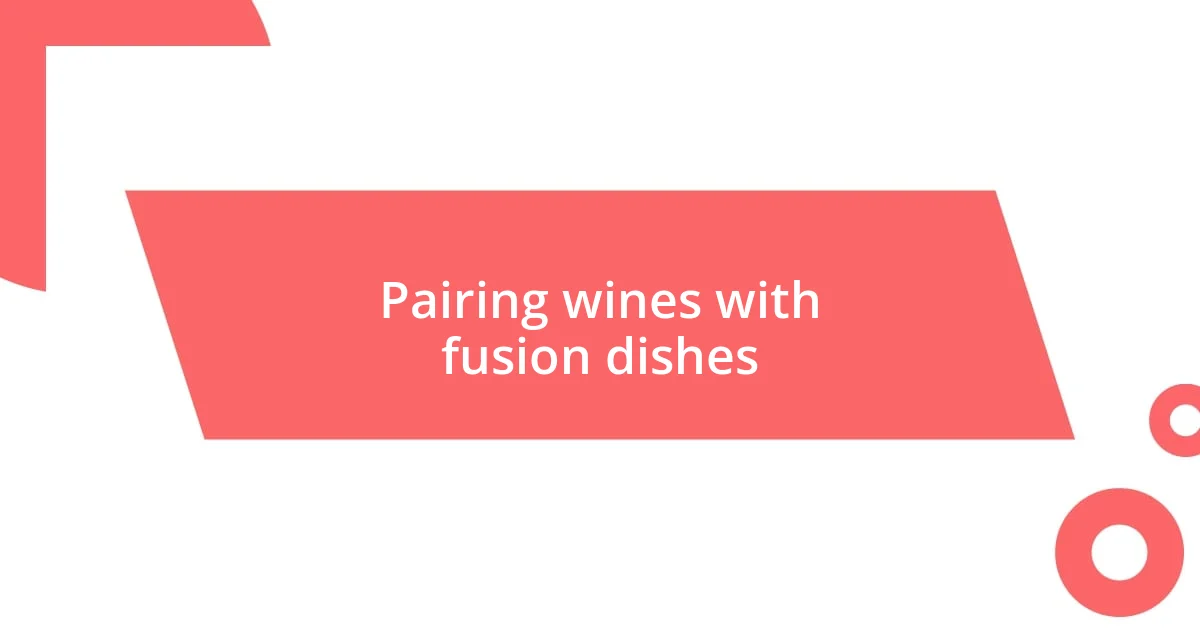
Pairing wines with fusion dishes
Wine pairing can elevate your Italian-Peruvian fusion dishes to new heights. When I paired a crisp Sauvignon Blanc with my Causa Relleno al Pesto, the balance was magical. The wine’s acidity cut through the creamy texture of the potatoes, enhancing the fresh basil notes of the pesto. Have you ever tasted a wine that perfectly complemented your meal, making the whole experience unforgettable?
For heartier dishes like Fettuccine con Ají de Gallina, I find a medium-bodied Malbec does wonders. I vividly recall a dinner where the deep, velvety notes of the Malbec melded beautifully with the nutty flavors of the chicken sauce. It was one of those moments where the synergy of flavors sparked joy and conversation, reminding us of the delightful journey fusion cuisine can take us on. Isn’t it thrilling when a wine can transport you to a different place and time?
Desserts deserve special attention too. The first time I served Chicha Morada Tiramisu with a sweet Moscato, I was blown away by the synergy. The floral notes of the wine danced alongside the rich flavors of the dessert, creating an experience that was both comforting and adventurous. Do you remember a dessert that made you feel both nostalgic and exhilarated? That’s the power of pairing wine with fusion dishes — it can evoke memories while introducing new sensations.










